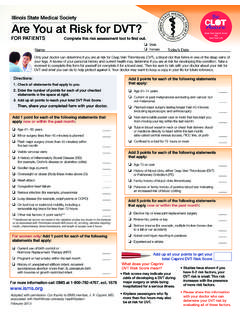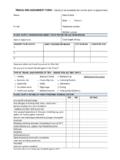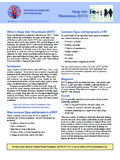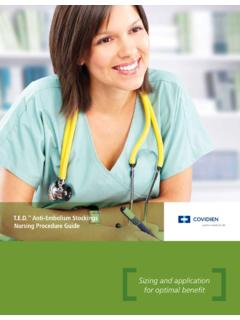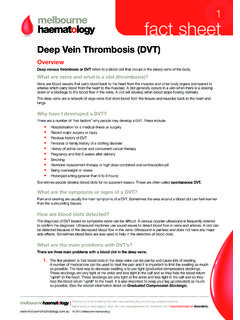Transcription of Midfoot Tarsometatarsal Joint Fusion - Sussex Foot …
1 This operation is intended to glue (fuse)one or more of the small joints in themidfoot together and may be performedin some cases as a day case is also called an arthrodesis of the Tarsometatarsal Joint most oftenperformed at the base of the first metatarsal. It is usually performed forpainful arthritis of this Joint , which may be affecting the function of theforefoot and which has not responded to other non-operative treatment. Thejoint surfaces are removed via an incision over the upper surface of the two 'raw' bone surfaces are then applied together and screws used tocompress them together and stabilise the Joint in the desired position. Thesescrews do not usually need to be removed subsequently although they canbe if need be. Once fused, the Joint will not move (although these joints donot usually have much motion) and this should greatly improve / abolish thepainful symptoms from this Joint .
2 Once Fusion is successful, you will be ableto wear most shoes (but not necessarily all types). There are no limits toexercise activities after the Recovery Facts Operation performed under general anaesthetic or regional anaesthetic You will be in a below knee cast / boot for 12 weeks post surgery You may not drive after the surgery for six weeks unless you have anautomatic vehicle and only the left foot has undergone surgery It takes approximately 6 to 9 months for the swelling to settle andfunction to improvesussexfoot& to surgeryYour surgeon may have discussed the following with you: Oral analgesics (pain relieving medication) Activity modification (reducing activity which brings on symptoms) Custom orthotics (insoles) Modified footwear Steroid injectionMain Risks Of SurgerySwelling - Initially the foot will be very swollen and needs swelling will disperse over the following weeks and months but will beapparent for up to 6-9 - The risk of deep infection occurring is approximately 1%.
3 You will be given intravenous antibiotics to help prevent this. It isimportant to keep the foot elevated over the first 10 days to reduce theswelling and risk of infection. If there is an infection, it may resolve with acourse of antibiotics but may result in failure of the position - ideally, the fusions are performed in a position thatalso optimum function and gives the best appearance. I take great effortsto judge the best position at surgery, but as you are asleep and lying down,it is not always possible to achieve this 'best' position. If the position is notoptimal following surgery, this can usually be accommodated by custominsoles and footwear. Rarely is further surgery - this is when the Joint fails to fuse and bone has not grownacross the Joint . We won't know whether this is the case for 6-12 risk of this is approximately 5%.
4 Smoking increases this risk 16 times. Ifa non-union does occur and is painful, then further surgery is usually damage - alongside the incisions are three nerves; thesuperficial peroneal, sural and saphenous nerves. They supply sensation tothe sides and the top of the foot and toes. They may be damaged during thesurgery and this may leave a patch of numbness, either at the side of thefoot or over the top of the foot and toes. This numbness may be temporaryor permanent. There is approximately a 10% risk of this - This stands for complex regional pain syndrome. It occurs rarely(1%) in a severe form and is not properly understood. It is thought to beinflammation of the nerves in the foot and it can also follow an injury. We do notknow why it occurs. It causes swelling, sensitivity of the skin, stiffness and is treatable but in its more severe form can takes many months to Vein Thrombosis (DVT) - This is a clot of blood in thedeep veins of the leg.
5 The risk of a clot occurring is reported as less than1% after foot and ankle surgery which is generally substantially lower thanafter hip or knee surgery. Suspicion of DVT is raised if the leg becomesvery swollen and painful. There are tests that can be performed to confirm17 Midfoot TarsometatarsalJoint FusionMetatarsalboneTarsometatarsal joints in themidfoot - siteof Fusion totreat pain(one or moreof these jointsfused) Cuneiformbone (tarsalbone)/ exclude the presence of a DVT. If confirmed, you will probably requiretreatment with a blood thinning agent (heparin preparation and / orwarfarin). The main concern with regards a DVT is that rarely (<1:1000chance with foot and ankle surgery) a piece of clot can break away in theleg and travel to the lungs which is much more serious and can be life-threatening. This is called a pulmonary embolus and signs of this includechest pain and shortness of the first 2 weeks following surgery it is likely that you will be treatedwith a blood thinning agent (LMWH - low molecular weight heparininjections) to minimise the risk of DVT / PE but this does not afford totalprotection and exercises to keep the toes and knee moving are advised, aswell as remaining generally you are concerned that the leg has become more swollen and painful(some swelling always occurs after surgery), or if you experience chestpain / shortness of breath, then you should contact the hospital, generalpractitioner, or accident and emergency department LeaveIn general 4 weeks off work is required for sedentary employment, 12weeks for standing or walking work and 16 weeks for manual / labourintensive work.
6 We will provide a sick certificate for the first 2 weeks;further certificates can be obtained from your have an AUTOMATIC VEHICLE and ONLY LEFT leg surgery then it is likely youwill be allowed to drive after your outpatient review at 2 weeks post you have a MANUAL VEHICLE or RIGHT leg surgery then you will NOT beable to drive until 3 months post notes are intended as a guide and some of the details may varyaccording to your individual surgery or because of special instructionsfrom your FusionMain Risks Of SurgeryTarsometatarsal FusionPost-operative Course17 Day 1 Below knee cast (backslab plaster) applied at end of surgery Expect some numbness in foot for 12-24 hour Pain medication and elevation of foot Blood drainage through cast expectedDay 2 An xray may be obtained Elevation of leg as much as possible for first 2 weeks Mobilisation non-weight bearing with physiotherapist (crutches / frame) Discharge home on day 2 - 3 usually possible No weight bearing on operated leg for first 6 weeks2 Weeks Outpatient review of wounds and removal stitches Application of new cast / removable boot May shower / bath if wounds healed No weight bearing on operated leg for 6 weeks May return to driving at this stage ONLY IF left leg surgery only andautomatic vehicle - otherwise unable to drive until 3 months post surgery6 Weeks Outpatient review - allowed to partial weight bear in cast / boot (~40%body weight)
7 To remain in boot until 3 months following surgery Using crutches / frame until 3 months post surgery12 weeks (3 months) Outpatient review with xray on arrival Usually the boot can be removed at this stage if xrays satisfactory Begin physiotherapy and rehabilitation program Gradually increase activity level as symptoms dictate May return to driving at this stage Begin physiotherapy strengthening / rehabilitation regime Strength improves over the first 9 months after surgery Expect some aching discomfort intermittently for the first 4-6 monthsDavid J RedfernMBBS, FRCS, FRCS (Tr & Orth)Consultant Orthopaedic SurgeonStephen P BendallMBBS, FRCS, FRCS (Orth)Consultant Orthopaedic SurgeonPrivate Secretary01273 627060 Direct Fax 01273 HeathSussex Nuffield HospitalBurrell Road, Haywards HeathEast Sussex RH16 1 UDTe l01444 456999 BrightonSussex Nuffield HospitalWarren Road, WoodingdeanEast Sussex BN2 6 DXTel 01273 627060sussexfoot&anklecentreThe Sussex Foot & Ankle Centre was founded in 2005 by two orthopaedic surgeons, David Redfernand Stephen Bendall, with the aim of providing a high quality specialist service for the diagnosisand treatment of all foot and ankle problems.
8 Both orthopaedic surgeons are specialists in problemsaffecting the foot and ankle and have many years of experience. They operate the service withoutpatient clinics at the Brighton and Haywards Heath Nuffield Sussex foot and ankle center strives to provide the best advice and treatment for all foot andankle problems. This includes sportsinjuries and trauma, bunions, metatarsalgia, and surgeons have particular interests in minimally invasive surgery and are at the forefront ofdeveloping such techniques in this surgeons are also academically very active and have appointments within the national(BOFAS) and international (EFAS) professional foot and ankle surgery
